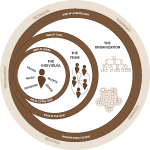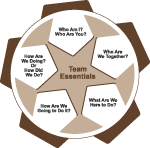by Linda Ernst
Team and group dynamics are influenced by many factors, such as the larger context in which the team operates, the organization, the team identity itself, and the mix of individuals within the team.
The Context of the Team
The country and geographic region form a larger culture in which the organization operates. All of these contribute to the economic, political, technical, and cultural climates in which the organization, the team, and the individuals operate.
The Organization
The kind of organization such as business, or non-profit, along with the organizational culture will influence the team functioning just as much as the division of the organization such as sales, research, operations etc.
The Team IdentityTeams have an identity of their own. This identity stems from the interrelationship of the larger culture, the  organizational culture, the team configuration, the nature of the work (purpose), and the qualities of the individuals. It is not the sum of the types, or preferences, or temperaments of the team members. There are many kinds of teams including ad hoc, project, executive, management, committees, and so on. Each team has a charter to fulfill a certain role in the organization. Team dynamics is heavily influence by the nature and purpose of the work to be done by the team.
organizational culture, the team configuration, the nature of the work (purpose), and the qualities of the individuals. It is not the sum of the types, or preferences, or temperaments of the team members. There are many kinds of teams including ad hoc, project, executive, management, committees, and so on. Each team has a charter to fulfill a certain role in the organization. Team dynamics is heavily influence by the nature and purpose of the work to be done by the team.
The Individuals
Within this mix of influences, are the individual team members who likely have specific kinds of work to perform and specific roles on the team. Individual members influence the team dynamics as well, so much so that when the composition of the team changes, the team dynamics will change.
The Five Essential Issues
Who Am I?—Who Are You?
Team members are individuals first, and they each bring different talents, perspectives, values, and experiences to the work of the team. The more self-awareness each team member has, the more actively he or she can contribute. The more each team member knows about the other team members, the better she or he can tap into the talents and experiences of others for better team performance.
the talents and experiences of others for better team performance.
Who Are We Together?
This essential involves the key aspects of relationships and communication. Individuals of different personality types are unique in the ways they build relationships and deal with conflict. When we try to forge better relationships, we can easily do something that undermines the relationship instead of improving it if we don’t take these differences into account. Personality differences show up in how we tend to communicate as well as how we like to be communicated with.
What Are We Here to Do?
Amazingly, teams often start right off doing the work rather than clarifying what the work is. They assume others see the assignments in the same ways they do. Much conflict and waste of time and resources could be avoided if teams spent a little bit of time to be sure they all share the same view of what they are to be doing and what the outcomes will look like.
Remember to take the time at the outset to discuss what the goals, mission, or tasks of the team are so you all on the same page. Don’t be blindsided by your own BLM agenda. The success of the team depends on getting those agendas out of the way.
How Are We Going to Do It?
Often people treat this as the most important issue on a team. It takes the form of who’s going to do what by when. However, this issue involves more than that. It involves both the processes and the production aspects of getting the work of the team done. People of different personality types will have different preferred approaches to doing the work and we tend to expect others to do the work the same way we do.
Production is often where our individual talents come to bear the most and where knowing yourself and others can really optimize the performance of the team. And of course there are pitfalls of each type’s approach to both process and production.
How Are We Doing? Or How Did We Do?
Finally, each team must have some measure of how they are doing. People of different personality types will have different perspectives on what constitutes good and adequate measurement. Don’t get stuck in your own preferences here.
Effective teamwork starts with understanding ourselves and ways we are different from others. When we know our own value to the team, we are in a better position to value and capitalize on the contributions of those who are different from us. We are also better able to think in terms of the team as a unit, instead of only our own interests—to move from “I” to “we.”
In the new Quick Guide to the 16 Personality Types and Teams we have described how each type is likely to behave on a team using the five team essentials outlined above. As we looked at the sixteen personality types and teamwork, we were aware that an overly stereotypic view of personality type and teams can decrease team functioning instead of enhancing it. We encourage you to keep in mind the interrelated influences on team dynamics and to remember that we are each complex and adaptable. Our behavior may not reflect our natural preferences, but instead, the demands of the situation and the ways we have developed.
